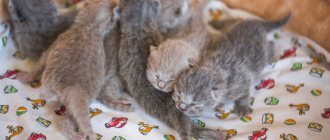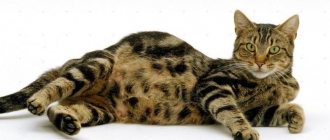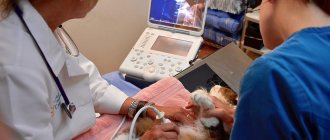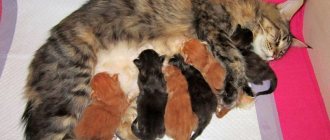Pregnant cat
Cat owners sooner or later face a situation when their pet, having reached physiological maturity, is preparing to have offspring. The only exceptions can be cases when the cat has been sterilized or has completely excluded contact with the opposite sex. Anticipation of the upcoming appearance of kittens is very exciting for owners. Therefore, it is advisable to find out about the upcoming event as soon as possible.
In the article, we talked about how to understand that a cat is pregnant, what signs indicate this, and diagnostic options. You will also learn the peculiarities of the first pregnancy and the peculiarities of caring for a cat.
How to tell if a cat is pregnant at home
Gestation by a cat lasts 58-70 days.
The period depends on the breed, age, number of fruits. The first signs of pregnancy in the first week are hidden, after two to three weeks of fertilization the first symptoms appear: toxicosis, drowsiness, frequent urination, changes in the mammary glands and behavior.
Cat behavior during pregnancy
During pregnancy, a cat undergoes a restructuring of the body, and morning sickness appears. The animal becomes lethargic, refuses food, outdoor games, communication with the owner, and visits the litter box more often.
Toxicosis is a temporary phenomenon, so the female’s appetite soon returns to normal and in some places increases. Taste preferences also change. The expectant mother asks for what she previously refused: raw meat, cheese, butter, olives. If there is a lack of vitamins, a cat may chew plaster, wires, or eat its own fur.
A pregnant pet, having gotten used to the situation, eventually becomes affectionate, requiring more attention and care.
Termination of heat
Cats go into heat differently. It occurs either once every three months and lasts up to 20 days, or once a month and lasts 3-5 days. Can a pregnant cat go into heat? Definitely no.
Typically, fertilization after mating occurs within 20-45 hours. Once conception has occurred, estrus stops. The female stops calling the cat, does not arch her back, does not roll on the floor, and calms down.
Abdominal rounding
You can tell if a cat is pregnant by looking at its belly. Starting from the 5th week, it becomes rounded and dense, located behind the ribs. At week 6, the growth of the abdominal cavity increases: an experienced veterinarian will determine the number of fetuses by palpation.
Rapid enlargement of the abdomen begins at 8 weeks. It lowers, positioning itself closer to the hips. By placing your hand on your stomach, you can feel the kittens moving.
Swelling of the nipples
Two weeks after mating, the cat's nipples become bright pink and enlarge due to hormonal changes. After 7 weeks, the hair surrounding the nipples partially falls out.
3-5 days before the birth of kittens, the mammary glands produce colostrum.
Clinical examination methods
Often, breeders, owners of cat nurseries and felinologists use modern clinical methods - hardware and laboratory - to determine whether a cat is pregnant after mating. The most popular are three of them.
Tests
This method of determining the presence of pregnancy in cats is based on the identification of relaxin in plasma or serum. This hormone begins to be produced in cats three weeks after fertilization, and its levels increase during pregnancy. The test is completely reliable: in the case of a false pregnancy, relaxin is not produced. The results of a rapid test for relaxin may be false positive if the cat has ovarian cysts.
Sometimes cat owners, having heard from friends that a cat’s pregnancy can be determined using a test, buy a regular, “human” rapid test at the pharmacy. But such a test is not suitable for a cat: it reacts to the hormone human chorionic gonadotropin, which is synthesized in the body of pregnant women, but is never produced in animals.
Ultrasound of the uterus
Ultrasound examination of the uterus (sonography) is a non-invasive diagnostic method that uses high-frequency sound waves to obtain images of internal organs. The technique allows you to determine already on the 15th day after mating whether the cat is pregnant. The movement of the fetuses is visible at a period of 1 month, and during pregnancy at 1.5 months, the doctor will be able to tell how many kittens are in the cat’s womb. True, it happens that a large kitten “overshadows” a small one, so the litter turns out to be larger than expected.
The ultrasound procedure takes no more than 20 minutes. Hair is removed from the lower part of the cat's peritoneum, a special gel is applied to the skin, after which the doctor runs a sensor over the area being examined. After the procedure, the gel is removed with a damp cloth.
X-ray
An x-ray is a high-contrast, two-dimensional image of the contents of a cat's uterus. Soft tissues transmit electromagnetic rays well and have a dark color in the picture, while dense tissues - bones - absorb X-ray radiation much more strongly, so they look almost white on film. Using radiography, you can determine whether a cat is pregnant 5-6 weeks after mating, when the main skeletal elements of the fetuses are formed.
X-ray of a pregnant cat as a diagnostic method
An X-ray image is used to identify the pathology of an animal’s pregnancy, count the number of embryos, and assess the quality of health of future offspring. The skeletons of kittens are visible after 44 days of fertilization.
In the early stages, x-rays are not indicated, since the image will only capture the tissue of the uterus.
The procedure involves the correct position of the cat: on its side or on its back. This position allows you to count the number of kittens by correlating the number of skulls and spines.
Determining if a cat is pregnant using ultrasound
Ultrasound of a cat during pregnancy is a common, painless and quick way to determine the period and problems of bearing offspring. The study will allow timely recognition of deteriorating animal health.
Diagnostics helps to see embryos as early as 2 weeks of pregnancy. After 4 weeks, the specialist will determine the exact number of kittens, check the activity of their hearts, and the condition of the cat itself. The movement of the fetuses is recorded, body parts and internal organs of the kittens are recognized. By the end of the 8th week, it is important to determine whether the amount of amniotic fluid is decreasing: the kittens are swallowing liquid. Reducing water levels and the size of the fetuses help the specialist determine the estimated due date for the pet.
Caring for mother and kittens
After giving birth, the cat may refuse to eat for 24 hours. It is still worth worrying about the availability of food, water and access to a waste tray.
The cat provides the kittens with full milk nutrition for 4 months. You should not touch or pick up kittens at first. There will be plenty of time to pet and watch the cute little kittens.
How to determine the gender of a kitten - learn to distinguish kittens yourself. Advice from breeders and veterinarians on how to distinguish the sex of kittens (120 photos and videos)How cats see - the structure of the organs of vision, colors and features of cat vision (video + photo)
How to make friends between a cat and a dog - ways and methods of teaching animals to live in the same house (110 photos)
How to determine how far along a cat's pregnancy is
The gestational age of a cat is determined taking into account the following characteristics:
- 2-3 weeks: nipples turn pink, swell, activity decreases, appetite disappears, morning vomiting, drowsiness;
- 4-5 weeks: the belly is rounded, increasing in size, appetite increases;
- 6-7 weeks: weight gain by 1.5-2 kg, the belly grows faster, being located closer to the hips, the cat becomes affectionate, requiring increased attention;
- 8-9 weeks: the belly goes down, a significant weight gain, the kittens are felt moving, the cat begins to worry, tries to be closer to the owner, looks for a secluded place of birth, lies more, eats a lot, often goes to the litter box, nipples secrete colostrum.
How to detect a false pregnancy in a cat
The condition of a false pregnancy in a cat is not uncommon. More often, sphinxes, oriental cats, rexes, and Siamese are subject to it, inheriting the vice from their parents.
False pregnancy is a condition in which an unfertilized cat experiences symptoms of pregnancy.
Causes of abnormal behavior:
- mating occurred with a sterile/castrated or sick cat;
- the female’s genitourinary system is disrupted;
- the cat has congenital hormonal disorders, in which a false pregnancy occurs without mating with a male.
False pregnancy is classified as a mental illness in animals.
Signs of false pregnancy:
- lethargy, increased sleep duration, increased anxiety;
- alienation or persistent begging for human affection;
- finding a place to give birth;
- caring for a sock, a soft toy, carrying it in your teeth like a kitten;
- frequent licking;
- slight discharge from the genitals and nipples;
- rounding, thickening of the abdomen;
- enlargement of the mammary glands;
- surges in appetite;
- improper functioning of the gastrointestinal tract;
- slight increase in body temperature.
Ultrasound diagnostics will make it possible to more accurately determine a false pregnancy.
Birth of kittens
The most difficult thing for people without specialized education is determining the onset of labor in a pet.
There are several characteristic signs of a cat:
- anxiety;
- poor appetite or complete refusal to eat;
- licks and breathes frequently;
- settles in a certain place and does not leave it.
The cat is able to cope with the birth of kittens. Excessive attention can cause stress in a cat, which often affects the process of giving birth to kittens.
If the birth is too long and bleeding appears, then you cannot do without the help of specialists.
How to detect a frozen pregnancy in a cat
Frozen pregnancy is a common phenomenon in which one or all embryos die in utero. This happens due to hormonal imbalances, infectious diseases, various pathologies of the body, poisoning with chemicals and drugs. In severe cases, miscarriage or death occurs due to infection of the body with cadaveric poison.
Ultrasound can detect non-viable embryos. If a pathology is detected, labor is stimulated. The problem cannot be delayed: a dead fetus is susceptible to decomposition, leading to infection of the cat’s body.
If live kittens are found, the pregnancy is not terminated. Dead fetuses will be released naturally during childbirth.
If a frozen pregnancy recurs, then the question of castration of the female arises.
Pregnancy in cats has some peculiarities that every breeder needs to know. The onset of fertilization and high-quality gestation of offspring is facilitated by puberty and the age of the female, depending on the breed, care, and climate. The optimal age for mating is 1.5 years.











